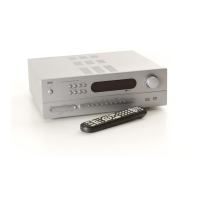
Do you have a question about the NAD T 743 and is the answer not in the manual?
| Channels | 7.1 |
|---|---|
| Frequency Response | 20 Hz - 20 kHz |
| Total Harmonic Distortion | 0.05% |
| Input Sensitivity | 200 mV |
| Signal-to-Noise Ratio | 100 dB |
| Input Impedance | 47 kOhms |
| Tuner Bands | AM/FM |
| Preset Station Qty | 30 |
| Digital Sound Processor (DSP) | Yes |
| Bass Control | Yes |
| Treble Control | Yes |
| HDMI Switching | No |
| Speaker Impedance | 4 - 8 ohms |
| Damping Factor | Greater than 100 |
Explains symbols like the lightning flash and exclamation point used for warnings.
General advice before operating the unit.
Guidelines for safe installation, covering water, heat, ventilation, and mounting.
Covers power sources, polarization, cord handling, and extension cords.
Recommendations for cleaning, service, and owner record-keeping.
Initial steps for unpacking and setting up the receiver.
Guidelines for selecting a suitable place for the receiver.
Lists items packed with the receiver.
Advice on keeping the original packaging for transport.
Guidance on selecting a suitable place for the receiver.
Explains NAD's design approach for transparency and quality.
Details NAD's Enhanced Ambience Recovery System and digital surround.
Focuses on user-friendly design and the HTR 2 remote.
Discusses system-integration options like trigger outputs.
Information on system expansion using pre-out and main-in jacks.
Introduction to the universal remote control.
Step-by-step guide to playing a DVD movie.
How to turn the receiver on/off and indicator lights.
Buttons for radio tuning and management.
Vacuum Fluorescent Display for information.
Adjusts master volume and other parameters.
Buttons for selecting inputs and listening modes.
Controls for adjusting channel levels and tone.
Connections for speakers and external sources.
Connecting FM and AM antennas.
Video output for monitor or television.
Analog stereo audio and digital audio inputs.
Connections for Soft Clipping, IR repeaters, and triggers.
Component video inputs and output for HDTV formats.
Power connection and switched outlet.
Speaker outputs and audio connections for recording/pre-outs.
Analog audio inputs for multichannel sources.
Initial considerations before setting up the receiver.
Tips to prevent hum and noise problems in audio systems.
How to display the main setup menu on the monitor.
Using the remote to navigate and modify settings.
Configuring input assignments for audio and video.
Setting up speaker configuration, size, and presence.
Selecting and adjusting listening modes.
Adjusting relative speaker levels for proper balance.
Guidance on using an SPL meter for level calibration.
Setting speaker-to-listener distances for delay timing.
Special listening and system options.
Settings for OSD background and temporary display.
Storing system configurations into presets.
Retrieving stored presets.
Choosing input sources using the remote.
Controlling the master volume level.
Silencing all audio channels.
Using the internal AM/FM tuner.
Information on FM and AM antenna connections.
Operations for selecting, tuning, and storing radio stations.
Adjusting FM mute and understanding Radio Data System.
Assigning and entering names for radio presets.
Explanation of the DTS digital surround format.
Explanation of the Dolby Digital surround format.
Description of Dolby Pro Logic and its II variations.
Modes optimized for movie and music soundtracks.
Listening modes for stereo or downmixed multichannel sources.
Surround processing for two-channel sources.
NAD's proprietary surround processing for natural ambience.
Stereo playback modes using different speaker configurations.
Decoding Dolby Digital and DTS signals.
Shows the current input signal's channel mode.
Cycling through available listening modes.
Adjusting parameters for PLII modes (Dimension, Center Width, Panorama).
Adjusting DYN. RANGE for Dolby Digital soundtracks.
Settings for Enhanced Stereo modes (ST1, ST2).
Table showing channel availability for different modes.
Real-time and menu-based adjustment of channel levels.
Adjusting bass and treble for front channels.
Technical specifications of the HTR 2 remote.
Operating the T 743 using the HTR 2 remote.
Teaching the remote new commands from other remotes.
Retaining function keys from one device page to another.
Copying commands between keys.
Creating and recording sequences of commands.
Running recorded macro commands.
Setting the duration for key illumination.
Resetting the remote to factory defaults.
Removing learned or copied commands.
Loading specific NAD remote code libraries.
Searching for compatible code-libraries.
Verifying the current code-library number.
Assigning the trigger output to an input.
Resolving various no sound problems.
Troubleshooting Dolby Digital and DTS signal issues.
Resolving remote or front panel control response problems.
Technical specifications for the amplifier.
Technical specifications for the tuner.
Dimensions and weight of the receiver.